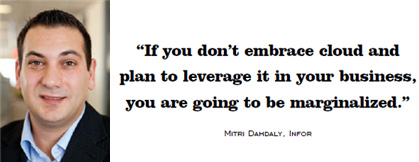Workforce Management Heads To The Cloud
By Gennifer Biggs, Business Solutions magazine.
Once this independent software vendor (ISV) overcame several common barriers to cloud, it brought 2 million users into the world of SaaS.

The cloud is a conundrum. It creates both opportunities and anxiety for you and your clients. It forces companies to choose between on-premise and hosted solutions, both of which come with pros and cons. For ISV Infor, talking with customers about that critical decision has grown easier because, as a software developer, it faced the same difficult decision a few years ago. Similar to many of its customers, the determination to head into the cloud came with many challenges.
Take Business Process Software To The Cloud, Or No?
It was nearly five years ago that Infor first saw the impact of cloud on the horizon, but as the world’s thirdlargest provider of enterprise applications, Infor was accustomed to offering its vertically specialized software, which includes solutions for enterprise resource planning (ERP), workforce management (WFM), enterprise asset and performance management, CRM, product life cycle management, financial and human capital management, and supply chain management, in the traditional perpetual licensing model. That meant a decision to invest in development of SaaS versions of its leading products was no simple choice. “In business today, you really have two options: You can stay the course you’ve always known, or you can adapt,” says Mitri Dahdaly, director of product strategy, workforce management, Infor. For the ISV, faced with competition from software leaders SAP and Oracle, taking the plunge into the cloud created a competitive advantage. Plus, since the path the ISV followed to the cloud involved many of the same considerations that its customers now face, it is not only more competitively positioned due to its cloud offering, it is much more capable of talking about cloud with its customers.
For Infor, the first step toward a SaaS portfolio was determining which of its software products were best-suited to cloud, then prioritizing migration of individual products to the cloud. “We evaluated the products primarily to set priorities for research and development, considering that some solutions are more suited to cloud than others,” explains Dahdaly. While all the solutions could (and probably will) be transitioned into SaaS products, Infor took the time to determine which provided the most competitive edge in a cloud version and which customers were clamoring for hosted solutions. Once the decision was made to take a particular solution to the cloud, the ISV then faced the technology-related hurdles that stand between on-premises software and SaaS.
Adding Software To The Cloud Creates Complexity
Much as an end user would face decisions about migrating certain solutions to the cloud and then preparing its infrastructure for interoperability with the cloud-based solutions, so did Infor. “There are a number of factors to consider since software in the perpetual model is not designed for upgrades across an entire customer base, nor is it scripted for select upgrades or international upgrades, so we had to tackle all that,” explains Dahdaly. For example, certain business process software is governed by different privacy laws in different states and countries, so a blanket upgrade cannot be applied. Infor also had to retrofit multitenancy (a principle in software architecture where a single instance of the software runs on a server, serving multiple client organizations) into its products, so from software codes to the infrastructure behind the software, Infor had its work cut out. “We built these products based on certain assumptions, and those assumptions change when you migrate to the cloud,” Dahdaly adds.
However, with all of those considerations came a greater understanding of the impact of cloud which has enabled Infor to better guide its clients through the process of evaluating the changes they may face in order to best leverage SaaS solutions. Because Infor has walked the path already — from interoperability between on-premise solutions and SaaS products to changes in its own infrastructure to support SaaS and even policies on handling SaaS security-related products — the ISV has real-life experience to share with its clients during their process of choosing cloud over on-premise.
Selling SaaS A Challenge For Sales
Dahdaly admits it was overhauling the ISV’s sales organization that posed the biggest challenge. “Changing the mindset of a team entrenched in selling perpetual software licenses was difficult; it is a different skill set,” admits Dahdaly. “You have to focus on enhancing their knowledge about the value — as well as both the limitations and advantages — of SaaS.” The transition took longer than Infor originally anticipated; what was expected to take only six weeks turned into nearly three months, primarily because the entire organization required education about the new go-to-market strategy, from sales to support. “Even our support calls were different because the data and logs we use to resolve issues were no longer with the customer, so that team had to be retrained as well,” explains Dahdaly. “But without investing those three months into that preparation, we would not have been successful in our transition, no matter how good our products were.”
Walking through all the new aspects of SaaS with the support and sales team empowered those groups to better relate to customers who faced similar questions or training within their own walls. “Anytime you can contextualize a problem that your customers are facing with your own experience in your organization, it’s a bonus,” says Dahdaly. With that common ground established, Infor’s sale organization can more quickly move on to discuss automated upgrades, fewer management responsibilities, pay-as-you-go, and other advantages of SaaS.

Hybrid Business Software Solution Complements SaaS
Since making its cloud investment about four years ago, Infor has seen double-digit growth. Dahdaly notes that virtually every RFP the ISV has fielded in the last year has included an inquiry about SaaS. For many of those new customers, the choice between cloud and on-premise comes down to the fewer management resources needed and the cost differential — SaaS simply delivers faster payback than on-premise software, and over time, that savings only grows. That said, Infor has identified a large group of existing customers who are torn over losing control of their data and leveraging the cloud despite cost savings and agility. For those folks, Infor offers an interesting option. “We have about 70 different software applications that can be mixed and matched, and within that choice is the option of putting some in the cloud and some on-premise,” explains Dahdaly.
That hybrid choice is rather unique since many SaaS vendors aren’t comfortable with the interoperability needed for those two types of applications to work together effectively. However, because Infor had grown its product line primarily through acquisition, it had deep experience with that issue and found it fairly simple to roll out the mixand- match option. “Our ION technology empowers a unified user experience because it integrates on- and off-premise solutions and pulls data for each product, regardless of where it lives,” says Dahdaly. With that option available, Infor expects to slowly migrate its clients, even the slow adopters, over to SaaS in the next five years, furthering a trend that already has 2 million end users in the cloud.
Overall, Dahdaly says the advice Infor shares with its clients is the same as it took to heart when faced with the decision to adapt to a SaaS platform. “If you don’t embrace cloud and plan to leverage it in your business, you are going to be marginalized because your competitors are definitely taking advantage of the agility and flexibility that comes with it. And that will eventually provide them with an edge, so you simply can’t be afraid to adapt.”

